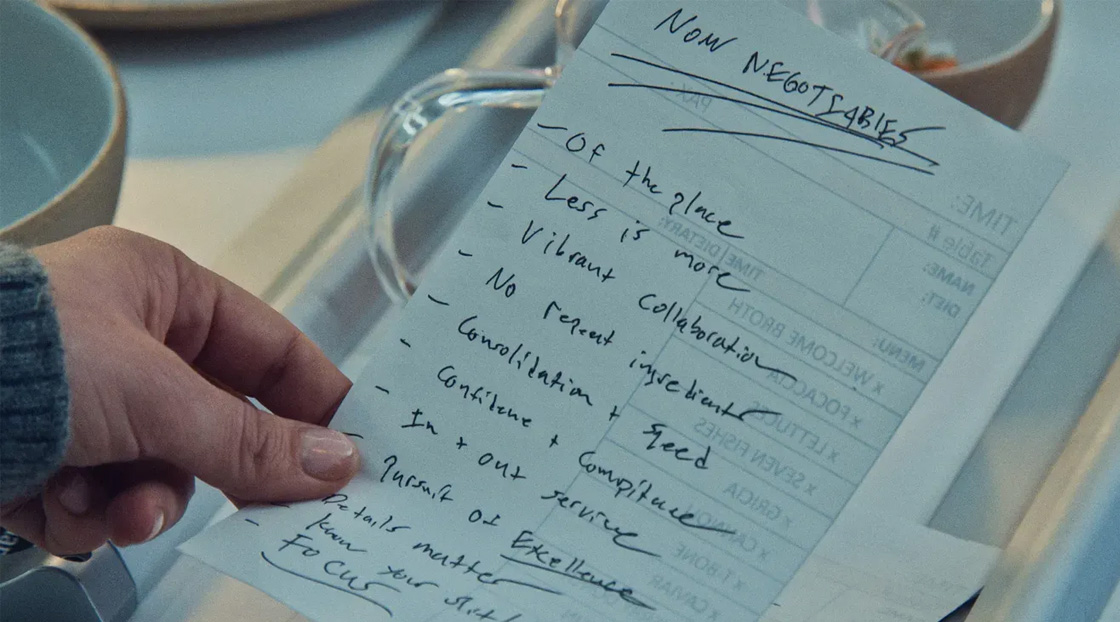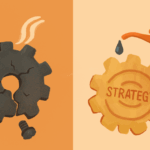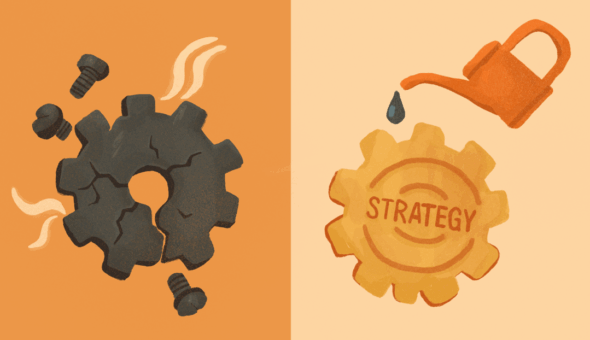The Bear is about a lot of things: the choreographed elegance of teamwork and the crippling consequence of poor leadership; the uplifting potential of upskilling in the workforce and the gravitational pull of both past and future. It’s also about legacy and the part each character has to play in re-envisioning an institution that has become inert.
But really, The Bear is about a rebrand. Reconciling the demands of executing a new vision for an entrenched brand in a way that builds a new legacy is the top challenge of any brand development initiative.
In season three, when Carmy scribbles his list of “non-negotiables,” it’s easy to dismiss it as a malignant artifact of his troubled past. But look closer. Those first 11 items (consolidated down to eight here) have immediate applicability to a higher education branding project — be it a refresh, rebrand, or otherwise — and the part your team can play in ensuring its success.
So, if you’re considering a branding initiative — in-house or with a strategic partner — read on.
Tl;DR
1. Of the Place
Do the foundational work before the project even kicks off, and it’ll pay off in the long term.
2. Less is More
Use a brand project to wash away outdated ornamentation and get back to brand basics.
3. Vibrant Collaboration
A branding project will take more than just cross-team collaboration. It’s going to take your entire institution.
4. No Compromises on Ingredients (Pursuit of Excellence)
For a fine dining restaurant, it’s all about flawless execution using top-notch ingredients. Branding is about impeccable construction of the finest verbal and visual elements to express your brand in a way that tells the right story for each audience and medium. If you cut a corner, it will show.
5. Consolidation and Speed (In + Out Service)
Want your brand to launch? Focus on processes and protocols long before your first focus group.
6. Confidence and Competence (Know Your Shit!!)
Want to execute and sustain a branding project? You and your team must own it. All of it. Address your skills gaps and set down the path of upskilling before the project starts.
7. Details Matter
A branding project isn’t just about sticking the landing. That comes last. But first, you have to pay attention to each brand element.
8. Focus
As a marketing and communications team responsible for managing the brand, it’s your job to change the conversation from “this is what we do” to “this is why people should care.”
1. Of the Place
Carmy may be referring to the French term “mise en place,” which means “putting in place” or “gathering.” Or, it could be about the need to stay true to your vision (read: authenticity). Regardless, everything — strategic plans, institutional research reports, enrollment and donorship trends and even the right people on the right teams — must be accounted for, organized and aligned before a project should begin.
Focus on your brand mise en place — and do it authentically. Know what’s feasible, what’s a stretch, and what’s pie-in-the-sky. Ask yourself (and your team) the following questions before you start.
- What is our primary objective — a completely new brand platform, soup-to-nuts? Just messaging, or is visual identity on the table? Know the differences and do your homework.
- What data do we need to inform the process?
- What is our baseline brand perception and awareness?
- Who needs to be part of this process?
- Who will manage the project?
- Who will need to be responsible, accountable, informed, and consulted throughout the process?
- What is a practical timeline for the institution and the primary team responsible for the branding initiative?
- Do we have the skills necessary to execute the project in-house? If not, how do we traverse the skills gap with a potential strategic partner?
- What is the budget — and is it enough?
- How will we launch what we build?
- How will we measure our success?
These questions are table stakes for a brand build. Far too often, institutions rush into a branding engagement without first devoting time to their mise en place, which is part of the reason some refreshed brands never see the light of day. Plan ahead and plan authentically.
2. Less is More
Every marketing and communications team has that closet filled with old alumni magazines, print pieces, framed ephemera and other artifacts of your brand’s expression over the years. Rather than clean it out, you just pile on your current brand materials, adding more content to the clutter.
Over time, brands accumulate baggage — both visually and verbally. A brand project done well is an exercise in addition by subtraction. The goal should be to shed the layers of adjectives and contextual copy. To purge all of those visual elements that have been added over the years. To, finally, put to rest the lingering vestiges of that brand campaign (that really wasn’t a brand campaign).Get back to basics and answer the following questions:
- Who do we serve, really?
- How do we serve them?
- What do we do very well in service of our core audiences?
- What is the relationship between what our institution offers and the advantages of those offerings?
- What are our core brand personality traits, and how should they manifest in our language and visuals?
- Why should anyone — from 18 to 80 — even care?
Strip away those layers of brand paint and get down to the original, bare planks.
3. Vibrant Collaboration
We all talk about the importance of teamwork — yet there is nothing like a brand project to lay bare how siloed we are. Case in point: If you’re the leader of an integrated marketing and communications team initiating a branding initiative, your team may be doing the work or liaising with a strategic partner to push the project forward.
However, it will require input from all corners of campus and representation from all constituent groups. It’s not just making sure all voices are heard. It’s waging diplomacy to build support for your team, and the project.
Just as kitchen staff must liaise with front-of-the-house staff, who work directly with customers, your team must find ways to meaningfully pull in and collaborate with partners from the following offices and groups.
- Advancement
- Admissions/Enrollment Management
- Student Life
- Athletics
- Current students
- Potential students
- Faculty
- Staff
- Alumni
- Trustees
- Community partners
Include them early and often, and you’ll ensure your brand is built through collaboration that brings people together.
4. No Compromises on Ingredients (Pursuit of Excellence)
Just like a perfectly composed plate of food must have balance, show restraint, and tell a story for a diner to enjoy, a brand must tell a measured, disciplined story for your target audience to consume. Every element — from your wordmark to the words on a page and the colors that bring them to life — must be of the highest brand quality.
Brand quality builds trust, and each element, from that vertical rule to the recording on your institutional voicemail, must adhere to the same standards. Otherwise, your audiences will know, and they’ll respond accordingly.
Before you initiate your branding project, answer these questions with your team and leadership.
- What does high quality mean to us regarding our brand? Visually? Verbally?
- What written and visual elements of the current brand platform do we consider to be low quality?
- What written and visual elements of the current brand platform do we consider to be high quality?
- What elements are we willing to compromise on, and what elements are non-negotiable?
Answer these questions first, and you’ll thank yourself by the time you get to launch.
5. Consolidation and Speed (In + Out Service)
One of the most common reasons brand projects miss milestones is a lack of planning and intentionality regarding the people, platforms, and processes necessary to move everything along.
Depending on the size, makeup, and culture of your institution, a branding initiative can take anywhere from eight to 14 months from kickoff to launch. Once the project kicks off, expect a steady cadence of tasks and milestones to keep your people busy.
But here’s the catch: Your marketing and communications team already has its day-to-day jobs (i.e., all the marketing and communications that still need to happen daily). This means it’s critical to ensure the following non-negotiables are in place on day one:
- a dedicated project manager for the lifespan of the project;
- an email alias to ensure that all members of your primary working group don’t miss an update;
- an AI tool, such as Otter.ai, that records, transcribes and summarizes meetings and interviews;
- a project management system where a full project plan can be built and tracked;
- a weekly meeting cadence, either internally or with your strategic partner, to keep the project moving forward;
- a regular meeting cadence with the leader(s) to whom you and your team are accountable; and
- a steady meeting cadence with trustees or other governing bodies to keep them updated, informed and involved.
The more efficient your operation, the more likely you’ll get the job done with all extremities intact.
6. Confidence and Competence (Know Your Shit!!)
Competence builds confidence. If you don’t have the right competencies before starting a branding project, how will you uphold it once it’s launched? Marketing and communications offices are often understaffed, especially as they are increasingly pulled toward enrollment marketing. Even with a strategic partner, what happens post-launch? How do you keep the momentum going?
Before beginning your branding initiative, conduct an assessment of your marketing and communications team’s brand management function to see where you sit on the spectrum, from weak and transactional to competent and high-performing. Take a cue from one of Carmy’s healthier leadership initiatives and consider upskilling your staff.
While you may not be able to send them to “stage” at a modernist institution in Copenhagen, there are so many free courses, podcasts and newsletters out there that can help align your people when it comes to branding. I enjoy Concept Bureau’s insights.
- What are the team’s strengths and weaknesses in managing your institutional brand?
- What skills does the team lack?
- What resources already exist to upskill the team?
- What are the KPIs you can use to track their progress?
- Depending on your runway, what is a suitable plan to progress the team to competence either before the project starts or by the time it concludes?
With the right skills at the table, you have a higher probability of claiming brand authority when liaising with the other offices and people necessary for success.
7. Details Matter
These are the details that bring it all together.
- Authenticity — is it truly us?
- Simplicity — what adornment can we lose?
- Collaboration — are the right people involved and contributing?
- Quality — does every element meet our expectation of brand quality?
- Efficiency — what processes do we have now, and which do we need to add to ensure speed without sacrificing quality?
- Competence — do we have the right skills in-house? If not, how do we upskill?
- Confidence — have we built brand authority as a unit?
- Excellence — what are our “non-negotiables” regarding the proper usage of the brand?
You could print out these eight bullet points and tack them to the wall of your office, cubicle or conference room because each element matters.
8. Focus
Higher education has a love affair with talking about features. “We’re R1! We’re highly ranked! We have a branded curriculum! We have faculty-to-student ratios! And did we mention that our faculty and students are excellent?!”
These are all important ingredients. But here’s a harsh reality: People need to know what’s in it for them to care about what you’re offering. That’s why it’s your job to constantly, vigorously and courageously recalibrate every conversation with your many stakeholders and constituencies from “This is what we do” to “Here’s why it’s consequential” or, to take a cue from Chef Thomas Keller’s cameo in episode 10 of season three, from ingredients to nourishment.
This requires intense and unified focus from each team member, day in and day out. Because it’s the advantages that build awareness and affinity. Features are table stakes.
And as we all know, once the table is set, the real work begins.







